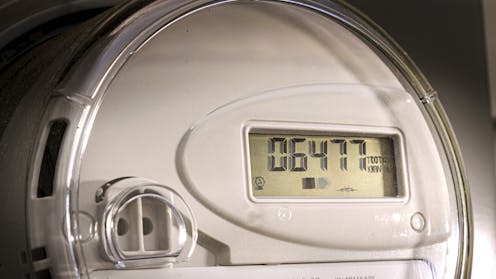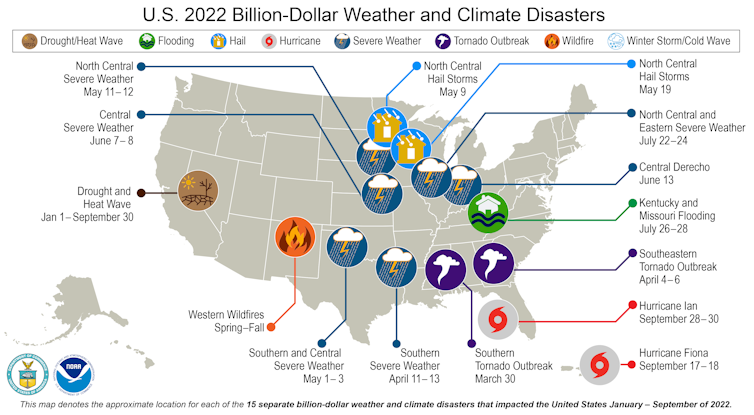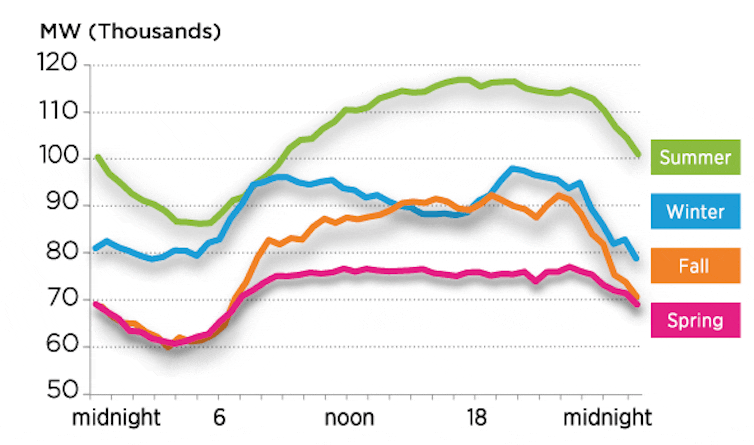
Americans want their electricity to be cheap, clean and reliable, but that trifecta is becoming more elusive, thanks to climate change. According to a 2021 report by the nonprofit research organization Climate Central, more than 80% of reported major outages across the U.S. from 2000 through 2021 were caused by weather extremes, such as heat waves, wildfires and tropical storms.
We are an economist and an electrical engineer investigating how increased use of two-way smart meter technology can be used to reduce greenhouse gas emissions from the electricity sector and help the economy withstand climate-driven weather extremes. As we see it, adapting the power system to increasingly volatile weather will require a combination of user-friendly technologies and economic incentives.

The promise of smart meters
Until recently, most U.S. households had mechanical electric meters. Utility employees would visit each home to take a monthly reading that the company would use to calculate the household’s bill.
Starting in the early 2000s, utilities began rolling out smart meters, also known as advanced metering infrastructure, or AMI. These electronic devices measure a home’s electricity consumption and communicate it to the utility wirelessly every few minutes.
Communication between the smart meter and the utility is a two-way channel, which enables the utility to remotely connect or disconnect power to a home. The U.S. Department of Energy estimates that as of 2020, over 90 million residential AMI systems had been installed nationwide. About two-thirds of electricity meters across the U.S. are now smart meters.
For utilities, smart meters reduce the cost of meter reading and make it possible to detect and respond to power outages quickly. The fine-grained usage data that smart meters provide can help utilities better understand and predict customer demand using data analytics and artificial intelligence tools.
With this information, utilities can manage their operations to help prevent blackouts due to lack of generating capacity.
Utilities are partnering with companies like Opower to provide customers with mobile apps and reports that help them monitor and understand their electricity usage. A typical report may allow a customer to compare her usage over 12 months with her 100 closest neighbors and 20 most energy-efficient neighbors.
Studies show that receiving such reports leads consumers to reduce their electricity consumption by about 2%. Reducing peak demand by a few percentage points can enable utilities to avoid blackouts during high demand periods.

During extreme weather events such as heat waves, utilities routinely issue conservation appeals to their customers. Smart meter data analytics can be used to pinpoint which customers actually respond to these requests.
Smart devices and dynamic pricing
Utilities are beginning to pair smart meters with other new technologies, pricing incentives and social “nudges” to encourage electricity conservation.
For example, companies such as Google, Ecobee, Emerson and Honeywell are now designing smart thermostats that are preprogrammed to meet individual customer preferences. As the temperature changes throughout the day, the thermostats take action autonomously, such as precooling the home when power demand is lower. It has been estimated that smart thermostats can reduce energy consumption by 10% to 15%.
It’s possible to further manage energy use by introducing dynamic pricing – real-time price shifts that are directly reflected in consumers’ electricity bills. Currently, most U.S. households pay a flat rate for every kilowatt-hour of electricity they use, regardless of how much it costs to generate it.
In the simplest version of dynamic pricing, all electricity consumers would face a higher real-time price for electricity when bad weather reduces the supply of power. For an electric utility that has deployed smart meters, the meters would signal to customers – perhaps via text message – that the price of power will increase over the next six hours. This would alert consumers to shut down computers and reduce discretionary power use.
Pricing experiments in Washington, D.C., and other cities have demonstrated that consumers reduce their electricity consumption when they face price spikes during peak electricity demand periods. If enough people and firms participated, aggregate demand for power would decline, reducing the systemwide risk of blackouts.
This strategy is also good for the environment. Utilities often resort to high-polluting power plants that run on fossil fuels when demand exceeds supply. These plants contribute to local air pollution and global greenhouse gas emissions.
Introducing critical peak pricing for electricity reduces this need for dirty power. Averting power blackouts also will reduce reliance on home generators, which often emit harmful particulate air pollution.
Keeping dynamic pricing fair
Clearly, some consumers can respond to price spikes more easily than others. For example, a person who uses home dialysis cannot easily reduce her electricity consumption on short notice.
Highly volatile electricity pricing without safeguards could trigger public backlash. This happened during the 2021 deep freeze in Texas, which exposed some consumers to astronomical electricity bills during a life-threatening cold wave.
Economists have devised pricing strategies to encourage energy conservation without price gouging vulnerable people. For example, a utility can use smart meter data and artificial intelligence to identify customers who are major electricity consumers but also respond to price increases by reducing their power usage. These consumers could be offered an annual financial incentive in return for enrolling in critical peak pricing programs.
Customers who voluntarily accept the deal would face price spikes on perhaps 15 days a year. They could protect themselves from large energy bills by investing in energy conservation measures, such as installing insulation, energy-efficient appliances or solar panels.
In aggregate, their expected response – reducing their power use during peak periods – would help to reduce blackout risk. Federal money from the recently enacted Inflation Reduction Act could be used to pay the upfront incentive fees.
This approach reflects the fact that a small percentage of electricity consumers typically account for a large share of total demand. If 10% of consumers account for 30% of an electric utility’s demand, and that group can be encouraged to reduce its consumption by 50%, then aggregate demand will decline by 15% during critical peak pricing events. The other 90% of consumers would not be exposed to price spikes.
Clean energy funding in the Inflation Reduction Act will represent the single largest investment in climate and energy in the U.S. to date. We believe targeting some of this funding toward programs that encourage adoption of smart energy measurement devices, along with introducing real-time price signals of resource scarcity, will help advance the clean energy transition.
The authors do not work for, consult, own shares in or receive funding from any company or organization that would benefit from this article, and have disclosed no relevant affiliations beyond their academic appointment.
This article was originally published on The Conversation. Read the original article.







